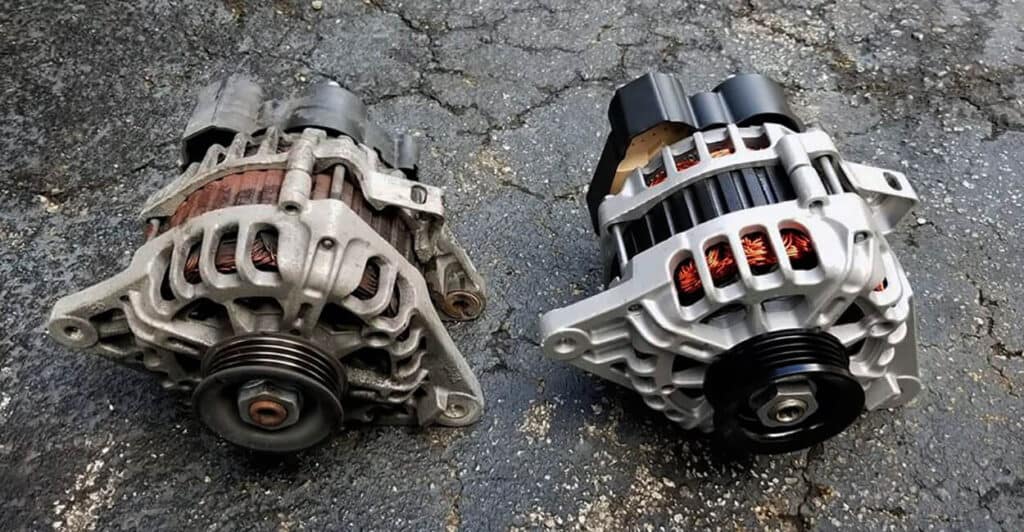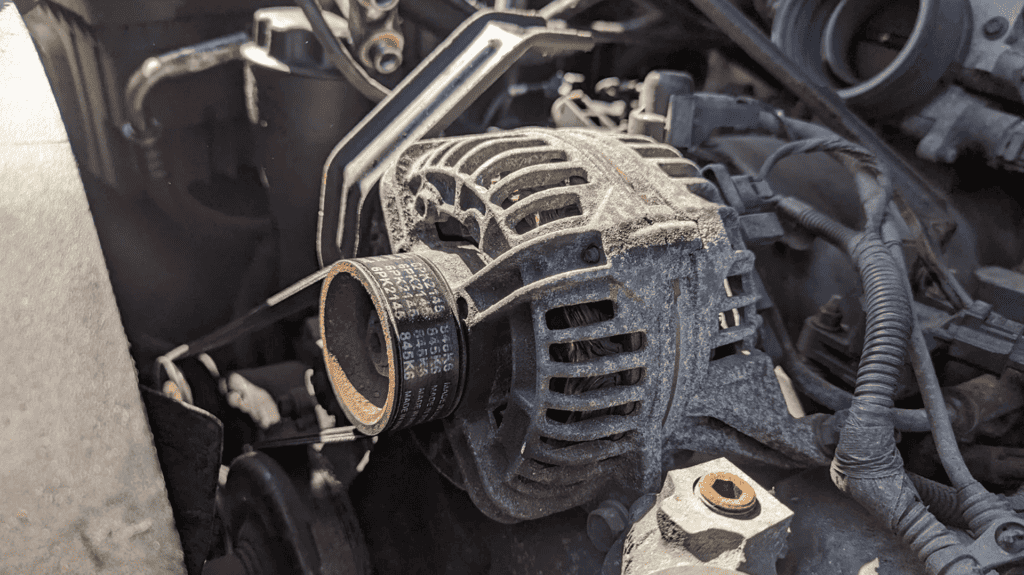Introduction: Understanding the Critical Role of an Alternator in Your Car’s Functionality
Your car is a marvel of modern engineering, and the alternator is one of its unsung heroes. The alternator’s job is to keep your battery charged and power your electrical systems while the engine is running. Sounds important, doesn’t it? That’s because it is! But what happens when this crucial component starts failing?
Tell-Tale Signs: How to Recognize a Failing Alternator
When it comes to a failing alternator, your car typically sends you SOS signals that are hard to ignore. Paying attention to these signs can help you recognize when your alternator needs a check-up. But what are these signals, and how can you read them? Let’s break it down:
• Dashboard Warning Lights: One of the first signs of an alternator issue is usually the illumination of the battery or alternator warning light on your dashboard. This light might be labeled “ALT” or “GEN” and is designed to give you a heads up that something isn’t right.
• Dimming Headlights: The alternator supplies power to your car’s electrical components. If your headlights are dimming or flickering, especially when you’re idling, it’s a strong indication that the alternator may be failing.
• Slow Power Windows: Your power windows might operate more sluggish than normal. This seemingly mundane inconvenience can actually be a symptom of an ailing alternator.
• Strange Noises: A failing alternator can produce a variety of sounds—whining, grinding, or even a growling noise. These noises emanate from the alternator’s pulley system and worn-out bearings.
• Electrical Failures: You may notice other electrical components, like your radio or air conditioning, acting up. These fluctuations in electrical power can be traced back to a malfunctioning alternator.
• Difficulty Starting the Car: If your car is having a hard time turning over or starting, it could be a battery issue, but it’s also possible that your alternator is not supplying enough charge to the battery.
• Battery Dies Frequently: If you find that your battery seems to die and require frequent jump-starting, the root issue might be a failing alternator rather than the battery itself.
Think of these as your vehicle’s way of whispering, “Hey, I need some help here!” allowing you to address the problem before you find yourself stranded on the side of the road.

Survival Time: How Long Can Your Car Operate with a Bad Alternator?
So you’ve been warned that your alternator is acting up, but you’re wondering how long you can push your luck. How long will a car run with a bad alternator? The short answer: not very long. A failing alternator won’t be able to recharge your car’s battery, which means you’ll run out of electrical power pretty quickly. If you’re lucky and the battery is fully charged, you may be able to drive for a few miles—think 5 to 10, not 50. But remember, that’s a best-case scenario. If your battery is already weakened or you have multiple electrical accessories running—like air conditioning, GPS, and radio—the distance could be much shorter.
Consider it a race against time, where your car’s functionality decreases with every second that passes. So, if your mechanic tells you your alternator is on its last legs, don’t try to eke out extra miles. You’ll risk not just a breakdown, but also damaging other essential systems in your car that depend on a stable power supply. It’s not a gamble worth taking.
Battery or Alternator? How to Diagnose the Real Culprit
By understanding these diagnostic methods, you can quickly identify whether the battery or the alternator is causing your car woes:
• Initial Symptoms for Both: Whether it’s your battery or alternator, you may experience dimming headlights, difficulty starting the car, or electrical accessories failing. These are warning signs that something in your electrical system isn’t working correctly.
• The Jumpstart Test: One of the quickest ways to figure out the issue is by jumpstarting your car. If the car starts but dies shortly after removing the jumper cables, the problem is likely with the alternator.
• Dashboard Warning Lights: Both problems might trigger warning lights on your dashboard. A battery light usually indicates a battery problem, while an ALT or GEN light suggests an alternator issue. However, some cars use the same light for both problems, so don’t solely rely on this.
• Use a Multimeter: For a more precise diagnosis, you can use a multimeter to check the voltage of the battery when the car is off and when it’s running. A significant drop in voltage while running indicates an alternator issue.
• Listen for Noises: Sometimes, a failing alternator can produce a grinding or whining noise due to its bearings failing. A dying battery doesn’t usually make a noise, but it might make a clicking sound when you try to start the car, indicating it doesn’t have enough power to turn over the engine.
• Visual Inspection: Check the alternator belt for wear and tear. A loose or damaged belt can affect the alternator’s performance. Also, look for corrosion around the battery terminals, which can indicate a battery issue.
• Professional Diagnosis: When in doubt, consult a qualified mechanic for a thorough inspection. They can run a series of tests to definitively tell you whether you’re dealing with a battery or alternator issue, or potentially something else entirely.
Driving Dangers: Will a Bad Alternator Cause Your Engine to Shut Off?
Here’s a nightmare scenario that no driver wants to contemplate: you’re cruising along the highway, and your engine suddenly shuts off. Could a failing alternator be the villain in this drama? Absolutely. A dying alternator won’t just affect your car’s battery and lights; it could actually cause your engine to shut off, plunging you into a potentially dangerous situation. When the alternator goes, it stops recharging the battery and supplying additional electrical systems, like your ignition and fuel systems. Once these systems lose power, your car will stall.
The risk isn’t just theoretical; it’s real and immediate. Imagine being in heavy traffic when this happens, or worse, on a high-speed freeway. The vehicle becomes harder to control, emergency systems may fail, and you could find yourself stranded in a precarious position. So when you start noticing signs of a failing alternator, don’t think you can keep going until you “find time” to get it fixed. Treat it as an emergency, because when it comes to keeping your engine running, the alternator plays a role that’s as crucial as it is underappreciated.
Rapid Drain: The Speed at Which a Bad Alternator Affects Your Battery
You might be cruising down the road, singing along to your favorite song, when suddenly, you notice that your car’s lights are dimming. Before you can even process what’s happening, your car comes to a grinding halt. So how fast can a bad alternator drain a battery? A malfunctioning alternator can drain a fully charged car battery within 30 minutes, leaving you stranded and helpless. An alternator in poor health can’t sustain the battery, and before you know it, essential functions like lighting, power steering, and even the ignition system may begin to fail, setting the stage for a breakdown.
And don’t assume that a new battery will solve all your problems. If your alternator is faulty, even a fresh battery won’t last long. Essentially, the alternator and the battery are partners in crime—the battery stores the power, but the alternator ensures that power is replenished. With a bad alternator, your battery turns into a ticking time bomb, its lifespan shortened with each passing mile. It’s not just about the inconvenience but also the strain it puts on your wallet, as you may need to replace the battery far sooner than expected.

Sudden Failures: Do Alternators Go Out Without Warning?
When it comes to car troubles, an alternator failure can be one of the most disconcerting experiences. Not all alternators give you the courtesy of a warning. Sometimes, the signs are so subtle that you may mistake them for minor glitches. For instance, you may see dimming lights or experience sluggish power windows. These are your vehicle’s desperate cries for help, but they can be easy to overlook.
Then, without so much as a heads-up, the alternator can suddenly give out. In some cases, it can feel like the automotive equivalent of a heart attack: sudden, intense, and potentially devastating. You might be making a quick run to the store or picking up your kids from school, and then you’re left stranded. It’s frustrating, unnerving, and can turn your day upside down. So yes, while some alternators exhibit symptoms before failing, others can go out as suddenly as a gust of wind extinguishes a candle, leaving you in the dark—sometimes literally.
Conclusion: Preventive Measures and Next Steps for Dealing with a Bad Alternator
Dealing with a bad alternator can be a nerve-wracking experience. Yet, recognizing the signs and understanding your options can turn a potentially crippling situation into a mere inconvenience. Always keep an eye on your dashboard lights and consider regular inspections as a preventive measure. If you find yourself in need of immediate help, don’t hesitate to reach out to Uchanics. They offer expert mobile mechanic services across Canada, bringing the garage to your doorstep. Don’t be left in the dark; let Uchanics light the way. Book an appointment today!
